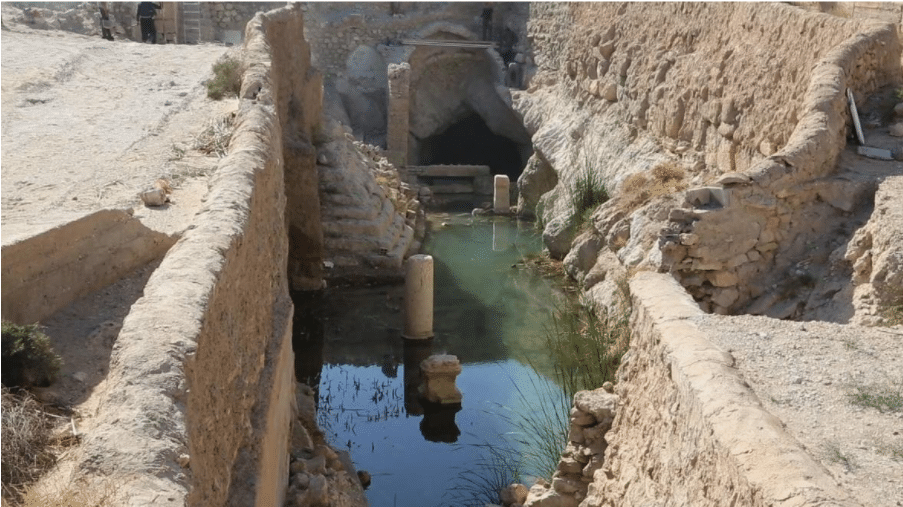
The Afqa Spring in Palmyra, first structure restored by the joint work of the Syrian and Russian governments together with UNESCO. Photo: RUPTLY.

Orinoco Tribune – News and opinion pieces about Venezuela and beyond
From Venezuela and made by Venezuelan Chavistas

The Afqa Spring in Palmyra, first structure restored by the joint work of the Syrian and Russian governments together with UNESCO. Photo: RUPTLY.
Restoration work of the archaeological site in the ancient city of Palmyra, Syria, is on going within the framework of a collaboration between Syria and Russia, with the support of UNESCO. The project started in October last year after UNESCO approved the 3-D models of the structures and monuments of the UNESCO World Heritage site that were prepared by experts from the Russian Academy of Sciences.
Palmyra, one of the oldest continuously inhabited cities in the world, located in the Syrian province of Homs, was taken over by the Islamic State in 2015, which then carried out massacres, and damaged, demolished, or vandalized most of the structures of the millennia-old city. The terrorists also ransacked the famous Museum of Palmyra and looted a number of invaluable artifacts, and tortured and killed the director of the museum, 82-year-old historian Khaled Assad in August 2015. The Syrian government was able to regain control of the city in 2017, with military assistance from Russia and Iran. Since then, plans for the restoration of the city started. The project took off last year under the supervision of the Directorate of Antiquities and Museums of Syria, with financing by the government of Syria and by Russia through its Association for the Preservation of Historical and Cultural Heritage.
The Afqa Spring site has been the first structure to be successfully restored, and was inaugurated on February 24. The spring originates from nine underground wells, and then flows through a creek inside a cave that was engraved in the hillside more than 6,000 years ago. The spring and the underground streams in the region are considered to be the lifeline of Palmyra, and could be a principal reason for the establishment of the city in the middle of the desert. A part of the cave was blown up by Islamic State terrorists in 2015, thus blocking the flow of the stream.
According to the Director of Antiquities of Homs province, Hossam Hamish, “the restoration work focused on removing rubble and debris from the channel of the stream, in addition to restoring the cave and its exit and the flow of the stream.”
Muhammad Nazir Awad, director general of Antiquities and Museums of Syria who was present at the inauguration event, added that the work also included “the excavation of the entire main staircase leading to the stream, and rebuilding the wall above the cave using brocaded stones similar to the ancient ones. Debris was also removed to reveal the surrounding archaeological layers and votive altars to the god Yahboul.”
“This rehabilitation work—although it may seem small—is of great importance as it symbolizes the return of life to Palmyra,” remarked Director General Awad. Syrian authorities are making efforts to facilitate the return of the people displaced from the city due to the ISIS rule of terror.
The restoration of the archeological structures of Palmyra is being carried out by a joint Syrian-Russian team consisting of specialists from Syria and members of the Voluntary Expeditionary Archaeological Corps of Russia. “This team will work on the restoration of all the monuments of Palmyra that were sabotaged by the terrorists,” informed Houman Saeed, joint director of Antiquities and Museums of Syria. “The project includes the Roman Theater, the Temple of Bol, the Complex of the Gods, the Triple Arches, the Grand Colonnade, and other structures.”
RELATED CONTENT: Cuban Communist Party Supports Syria in Fight Against Terrorism
Timur Karmov, the head of the Russian team, explained the nature of his association’s work. “Our principle is the preservation of cultural and historical heritage. We decided to complete the restoration of this spring first because of its historical as well as economic importance to the city of Palmyra. As this millennia-old stream flows again, farmers will be motivated to return to their fields and orchards in the oasis region,” thus contributing to the Syrian government’s program of return of refugees.
Karmov clarified that the reconstruction works in Palmyra are part of an agreement between Syria and Russia to restore the ancient sites damaged or vandalized by terrorist groups that were financed by the US and its allies. Russian experts will assess the condition of all the 758 archaeological monuments and sites in Syria, and especially those that are on the UNESCO World Heritage list, and assist in the rehabilitation of all the historical structures that were sabotaged.
Several terrorist groups, mostly offshoots of the Islamic State, armed and funded by the US, Turkey, Israel, and some European countries, are still active in many parts of Syria and continue to remain a threat to the safety and security of both the Syrian people and the cultural heritage of the nation.
Featured image: The Afqa Spring in Palmyra, first structure restored by the joint work of the Syrian and Russian governments together with UNESCO. Photo: RUPTLY.
Special for Orinoco Tribune by Saheli Chowdhury
OT/SC/JRE/DD/EF

Saheli Chowdhury is from West Bengal, India, studying physics for a profession, but with a passion for writing. She is interested in history and popular movements around the world, especially in the Global South. She is a co-editor and contributor for Orinoco Tribune.